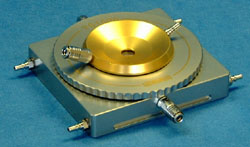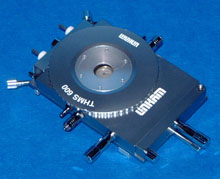THMS600 and TS1500 Stages

the TS1500- heats from room temp to 1500 degrees C.
*Has one TMS93 control box
*If you're going to heat 300 degrees C or above use the Ehein water pump
*If heating, use N2 gas purge

the
THMS600-
cools to -200 and heats to 600
degrees C
*Has one TMS93 and one LNP control
box
*If you're going to heat 300 degrees C or above use the
Ehein water pump
*If heating, use N2 gas purge
*If cooling, use 2 liter LN2 dewer
- Ehein pump
- Used to keep
the stages' body cool.
Attach all the tubes. *Be sure these are hooked together before running
pump!* Fill the
pump up with demineralized water. One tube attaches to the front of the
pump and the tube with only one metal attachment goes into the tall green
tube on the side
of the pump. Plug in the pump.
If it makes a lot of noise but doesn't run, there's not enough water in
the reservoir. Unplug the front tube and you should see the water level in
the green tube drop. Fill the green tube slowly with water, letting it
equilibrate with the water in the reservoir. When enough water has been
added, plug tube back in front. Plug in and it should run.water cooling diagram for TS1500
- Gas Purge
- If heating to high temperatures, it's often a good idea to pump in
some
inert gas to keep stuff from oxidizing and dirtying the slides. Make sure
the N2 is turned on in the web lab room (Arms 358), about 2-3 PSI, and
the carrier
gas is turned on behind the spectrometer. Hook the tube into the clasp
perpendicular to the side with all the wires. Make sure the an empty clasp
is letting the gas out on the opposite side. be sure to turn off the main
N2 tank when done for the day.
-
LN2 cooling for THMS600
-
Connect the digital plug to the lower control box. Connect the tubes from
the upper control box to the left thick tube and the tiny tube on the left
side of the stage.
The tiny individual tube with the metal clips on the end is placed near
the viewing lens on top of the stage. It prevents condensation on the
window. The metal feet fit
into the holes around the lens (though not well). The pump tubes again get
attached, both on the end where the control box attaches. The LN2 dewer
also attaches on this end, on the right. Make sure it's at least
half-full. When you put the top on- do not take back out! Frost will build
up on the little screen on the inside. Before completely
shutting the container, let it equilibrate. The snaps should close easily
after the noise has settled down. LN2 cooling
diagram
-
TMS93 control boxes
-
To start a new run, hit NEW (8). The underscore
indicates what blank is being filled in. First is RATE then LIMIT, then
MIN. Rate is how fast you want it to go. the machine will tell you if
you're too fast. LIMIT is the final temperature you want to reach and MIN
is how long the machine will hold the temperature you requested. After
inputting all these, hit ENTER and ENTER again. Then hit START(0). To
change any control, hit its button RATE, LIMIT, or MIN and enter the new
number and hit enter. If you
hit EXIT twice, the machine will drop all that it is doing and just go
back to room temp.
-
LNP control box
-
The THMS600 top control box has a manual/automatic switch for the LN2
pump. It automatic setting works just fine. Make sure this box is working
before cooling.
-
Attaching the stages
-
Take off the rotating microscope stage. Both the
heating stages will fit on, just tighten the feet until they're under the
path of the beam. turn on VIEW and an upper light to align. Often you will
have to lower the power of your lenses- 5X top and bottom works pretty
well, though 4X on the bottom would be a little bit better. Extra lenses
can be removed because they often get in the way with the cooling
tubes. If you need to take off the feet for any reason, use a metric
hexagonal wrench.
-
Fix
-
The stage windows get dirty and broken. To clean them, use a damp qtip and
dry using a khimwipe. The supersonic cleaner can also be used. To fix a
broken window, unscrew the top of the stage by hand or using opened
pliers. Replace the window, restacking the silicon rings. If the rings are
dirty, they can be cleaned with soap and water.
Linkam's Website
back to spectrometers

